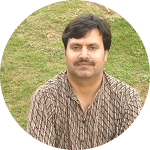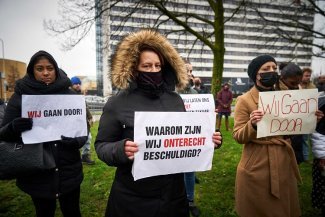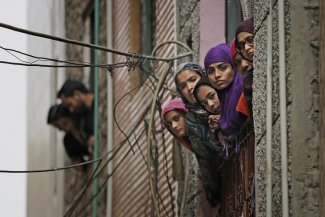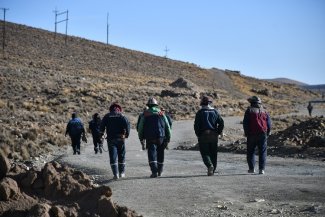Mourners carry the body of Amir Khan, 30, who was killed by a Hindu mob during anti-Muslim riots in north-east Delhi on 29 February 2020. The proliferation of online hate speech in India has resulted in a wave of anti-Muslim attacks in recent years. Amir’s body and that of his brother, Hashim Ali, 19, were recovered from a drain.
Yati Narsinghanand, the head priest of a powerful temple in Uttar Pradesh, India’s most populous state, first made national headlines in 2019 when a local TV station devoted a news item to the weapons training he conducted on temple grounds for Hindu youth and boys.
His dramatic rise as a poster boy for ‘Hindutva’, India’s reigning anti-Muslim political ideology, was fuelled by the inflammatory videos he subsequently began sharing on social media platforms, where they garnered millions of views. In December 2021, Narsinghanand was the main organiser behind a religious assembly known as Dharam Sansad in Haridwar, an Uttar Pradesh city, where along with other leading priests, he openly called for the genocide of Muslims.
Narsinghanand may be one of the most conspicuous hatemongers, but there are scores of religious preachers in India who stoke hate against minorities online. Muslims, which account for 14.2 per cent of India’s population according to a 2011 census, making them India’s largest minority, have especially been targeted.
Just across the border, in Pakistan, online hate speech has also been flourishing. Here Hindus, who form just 1.9 per cent of the country’s population, and Muslim sects like the Shias and Ahmadis, have borne the brunt of the extremist and inflammatory content on social media.
Tehreek-e-Labbaik Pakistan, a Pakistani far-right extremist political party, has especially used social media to mobilise public opinion on religious issues.
According to a report by the Islamabad-based policy research institute G5 Internet Observatory, the party has the “biggest firepower” on Pakistani Twitter, meaning their social media posts are most likely to go viral and lead to real-world harm.
Hate videos quickly and often go viral across South Asia, garnering thousands of views before they are identified and removed by social media giants like Google and Meta. Videos of the 2021 anti-Muslim religious assembly in Haridwar trended on social media for days before they were taken down. Even then, snippets of the videos continued to play to a large viewership on the country’s TV news channels.
The recent proliferation of online hate speech has had offline consequences. At the end of 2021, hundreds of people in Sialkot, a city in Pakistan’s Punjab province, killed Priyantha Kumara, a Christian factory manager from Sri Lanka. He was targeted because he had reportedly removed posters of the extreme right-wing party Tehreek-e-Labbaik Pakistan that featured Quranic verses from factory machinery. After the news of his removal of the posters spread, an enraged mob descended on the factory, dragged Kumara out, beat him to death and set his body on fire. India, meanwhile, has seen a wave of violent, sometimes deadly anti-Muslim attacks by Hindu mobs in recent years.
“A tsunami of hate”
Under the far-right, Narendra Modi-led government, hate speech in India has become more and more communal in nature – directed at Pakistan, Indian Muslims and their Kashmiri counterparts. In Pakistan, meanwhile, it is largely a sectarian phenomenon that has targeted Muslim sects like the Shias and Ahmadis.
The rise of unbridled hate speech against Muslims in India is generally traced to the rise to power of India’s current ruling political party, the Hindu-nationalist Bharatiya Janata Party (BJP) in 2014. In Pakistan, on the other hand, a 2014 study attributes the first major instance of online hate speech in the country to the 2011 killing of then Punjab governor Salman Taseer by his bodyguard Mumtaz Qadiri over the former’s opposition to Pakistan’s blasphemy laws.
The South Asia Collective, a group of human rights activists and organisations that seek to document the condition of the region’s minorities, recently produced a report on hate trends in India, Pakistan, Sri Lanka, Nepal, Afghanistan and Bangladesh.
The report warns of a “tsunami of hate” in India in particular. India’s ruling political party BJP “continues to sow division as it seeks to consolidate its electoral majority as a means to realise its Hindu nationalist goal of refashioning multi-religious, multi-ethnic India into a Hindu rashtra (nation),” the report states. “To this end, it has established domineering control over the print, broadcast, and social media, where a large number of BJP-allied actors now work in coordination to spread anti-minority hate messaging,” the report goes on.
As for Pakistan, the South Asia Collective study highlights that religious minorities in the country face an onslaught of violence, discrimination, and hate speech “that deteriorates their quality of life and perpetuates a culture of fear”. The collective declined to comment on the report when contacted by Equal Times.
Raza Rumi, a Pakistani policy analyst and journalist based in the US, says the current proliferation of online hate speech in India and Pakistan is unprecedented. “Over the decades, Pakistan’s hate speech has moved away from being anti-India and anti-Hindu and become more and more intra-Muslim. The biggest concern for the successive governments has been the rise of intolerant sectarian hate speech that was encouraged by the jihad project in Afghanistan and later the rise of the Taliban movement in Afghanistan and Pakistan,” Rumi says.
“There is also hate speech within Pakistan’s political arena, with the different political parties using very strong and antisemitic language against their rivals – politicians are frequently accused of being ‘Jewish agents’ – but references to India and Hindus have declined over the years,” Rumi explains. “In fact, India doesn’t even feature in the political campaigns. The only reference made with respect to India is the treatment meted out to Kashmiris by the Indian state.”
Tech giants struggling to curb online hate speech
Social media has supercharged the proliferation of hate speech across South Asia, with hundreds of videos seeking to promote hate for minorities uploaded to WhatsApp, YouTube, Facebook and Twitter in various languages every day. The algorithms of these social media platforms, which many experts and critics have said amplify divisive content, moreover ensure that those posts reach wide audiences.
The report on hate trends in South Asia notes that all major Indian political parties now have dedicated social media wings, but that the ‘IT Cell’ – a network of online influencers and hate-mongers – of the BJP ruling party and other right-wing groups within its ecosystem, seem to be far more sophisticated, well-funded and organised.
Over the last years, online hate has become “a way of life” with events such as elections only aggravating it, a third-party reviewer for Google who was not authorised to speak to the media tells Equal Times.
In a country such as India, where many languages and dialects are spoken, identifying and combating hate speech poses an inherent difficulty to social media giants like Meta and Google. As in many other parts of the world, Meta and Google have outsourced the identification of harmful posts in South Asia to third parties. Content moderators employed by these third-party companies have complained of inadequate training and on-the-job trauma from reviewing post after disturbing post.
The algorithms of tech giants have also struggled to identify hateful posts, as individual users and hate groups have learnt how to tweak terms to escape the algorithm. For example, ‘Muslim’ becomes ‘Muzlim’, ‘Islam’ becomes ‘Izlam’ and ‘Jihadi’ becomes ‘Jih@di’. Similarly, ‘Katua’, a derogatory term for Muslims, becomes ‘K2A’.
Meta has deployed few resources to tackle hate speech outside the US. Facebook spends 87 per cent of its global budget on identifying and classifying misinformation in the US, which accounts for just 10 per cent of the social network’s daily active users, according to internal documents leaked by whistle-blower Frances Haugen in 2021.
These figures didn’t include the company’s third-party fact-checking partners, most of whom are outside the US. Facebook works with these fact-checking organisations to identify, rate and review viral misinformation across Facebook, Instagram and WhatsApp and to reduce the spread of problematic content across these apps.
Facebook has hired ten fact-checking partners in 11 major languages in India, a Facebook India employee tells Equal Times. He did not want to be identified because he was not authorised to speak to the media. “India has one of the largest fact-checking networks for Meta across the world,” the person says. “We do use machine learning as well to do some sort of content moderation,” he says, adding that relying on machine learning only would not suffice. “It is human intervention as well that is required.”
Other than machine learning and third-party fact-checkers, tech giants like Meta are also relying on individual users to identify and report hateful posts. “Every report that we see, we take it very seriously and we take action on it,” the Facebook India employee says.
In India, Google has participated in initiatives to teach people to critically assess information shared on social media. One such initiative is Factshala, a news and information literacy programme launched by the international media development non-profit Internews in collaboration with the India-based digital media and information initiative DataLEADS and with support from Google.org, Google’s charitable arm, and Google News Initiative.
The proliferation of online hate speech in South Asia nevertheless remains a big challenge for Google, Meta and Twitter, with new, hate-filled videos posted to social media platforms every day. Almost seven months after the 2021 religious gathering in Uttar Pradesh, video snippets of Narsinghanand calling for the genocide of Muslims can still be found online.













